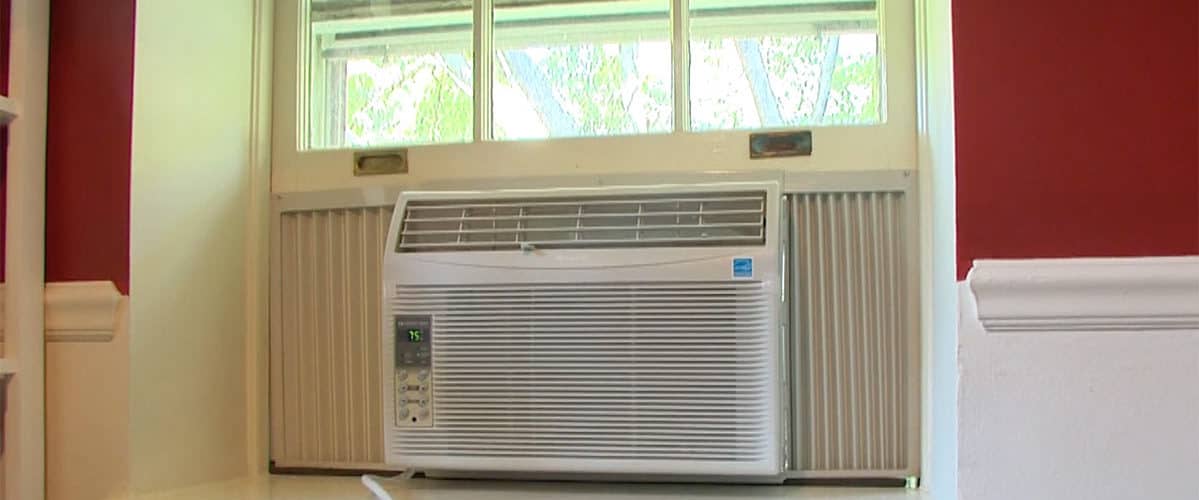There are many factors to take into consideration when looking to purchase a window unit air conditioner. Experts have suggested that prior to purchasing your window AC unit you need to consider things like high ceilings, doors, sun exposure and windows. The output capacity is increased by all these factors. Output capacity is measured in BTUs.
The federal government has an Energy Star size chart. The Energy Star size chart is higher than the ConsumerReports.org’s estimates for size. These two estimates have been combined below to help supply you with a ‘general’ sizing chart for window air conditioners. You need to calculate your room’s square footage. Do this by multiplying your room’s length by its width.
Your climate will also make huge differences in your air conditioner’s efficiency. Remember that the calculations in the charts are all based on temperatures in the summer (high 80s & low 90s). If your climate is milder than the standard temperatures used for these calculations, save yourself money and buy a unit that is less powerful. However, if your summer temperatures are generally above 100°, consider an AC unit with approximately a 50% higher output. *In high humidity climates, this is frequently seen.
BTU NEEDED FOR A LESS SUNNY ROOM
-100-250 sq. ft
5,000-6,000 BTU
-250-350 sq. ft
6,000-7,000 BTU
-350-450 sq. ft
7,700-9,000 BTU
-450-550 sq. ft
10,000-11,000 BTU
-550-700 sq. ft
12,000-13,500 BTU
BTU NEEDED FOR A SUNNIER ROOM
-100-250 sq. ft
5,500-6,600 BTU
-250-350 sq. ft
7,000-7,700 BTU
-350-450 sq. ft
9,000-10,000 BTU
-450-550 sq. ft
11,000-13,500 BTU
-550-700 sq. ft
13,500-15,000 BTU
For a room air conditioner with 8,000 BTU or less, that unit’s EER has to be no less than 9.7 (the better number is the higher number). Calculate a 10% savings per point difference. All of the new appliances have to carry an EnergyGuide decal listing the energy consumption of the unit in kilowatts as well as an estimation of the unit’s annual operation costs.
Contents
TIPS TO CONSIDER WHEN CHOOSING A ROOM AIR CONDITIONER
- Be sure to purchase the correct size room air conditioner. An air conditioner is used to remove moisture as well as cool a room. If you have a unit that is too small, it won’t be able to cool the room enough. An air conditioner that is too large will not be able to remove the humidity effectively.
- Don’t forget to think about how easy the air conditioner can be installed. Even a small air conditioner is rather heavy. The larger units can weigh in excess of 100 pounds. A chassis that slides-in will make installation somewhat easier because the lighter portion of the unit is installed first, however it can take longer to install.
- Look for any special requirements for the air conditioner. Some very large air conditioners need a 220-volt plug. Some units have louvers able to move in multiple directions to redirect the blowing air to where you would like it. If the unit has filters, check to see how simple the removal and replacement of the filter is. Many experts have stated that running a window unit on a circuit by itself to keep from causing an electrical overload is important.
- Try to obtain any of the ‘convenience features’ you want.
- Think about the noise level you can withstand. When using the unit in a bedroom, quiet operation may be necessary to ensure a good night’s sleep.
- Purchase the highest-efficiency air conditioner you are able to afford. You will probably pay a little more for it, but you will surely save on your electric bill over the lifetime of the unit. Sometimes you can find the models that are more efficient for the same price as the less efficient model.
INSTALLATION OF YOUR WINDOW AIR CONDITIONER
When you are installing your air conditioner be sure to follow all the instructions from the manufacturer carefully. You must also seal tightly around the unit to keep it stable and keep the cooled air inside the room. To prevent the airflow from coming in around the air conditioner, apply weather-stripping to the area the air is leaking through.
MAINTAINING YOUR WINDOW AIR CONDITIONER
Keep the coils, filter of the unit clean and replace as manufacturer’s recommendation.
PRE-SEASON MAINTENANCE
-Wash the foam filter with warm water and dish soap then let it drip dry, if necessary replacement of the filter can be done very inexpensively.
-Remove the air conditioner from the window and take off the ‘outside housing.’ Remove the dirt by vacuuming the inside to remove leaves, dirt and bugs.
-Cover the electrical parts of the unit with plastic and wipe the inside out with a dampened cloth. With the unit removed from the window, clean the sill and repair the window if necessary.
-Once the unit is dry, reinstall it and reseal with weather-stripping.



